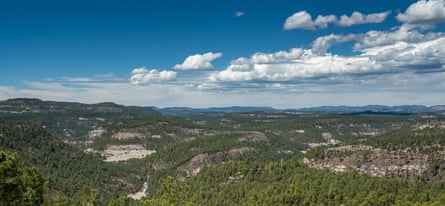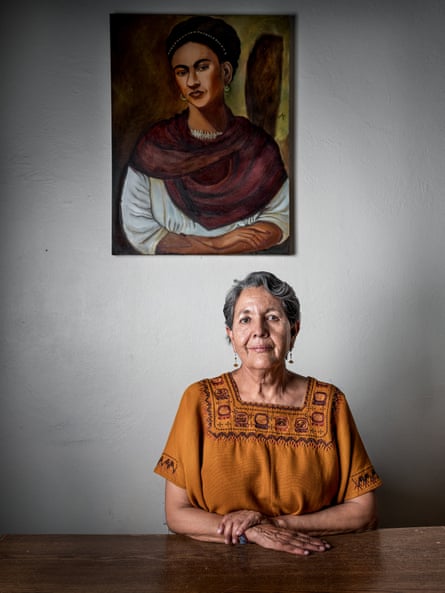Not all land defenders fight in remote forests and coastlands. Some take the battle to the centres of power: to courtrooms, parliament buildings and corporate headquarters. The veneer of urban civility may be glossier here, but the struggle is no less dangerous. In some cases, it can be worse.
Isela Gonzalez has been threatened more times than she can remember by university-educated men in suits, whose business interests – in logging, mining, agriculture and narcotics – are challenged by her work as director of Alianza Sierra Madre to protect indigenous land rights in Mexico’s western Sierra Madre.
The warnings have been muttered on steps outside legal hearings, whispered on the phone, or via conversations she has been deliberately allowed to overhear. They are not idle.
The nurse-turned-activist has seen dozens of her fellow campaigners murdered in recent years. Armed guards have been deployed by the state to provide her with 24-hour protection, panic-buttons have been installed in her office, locks have been upgraded in her home, and she and her staff have received crisis training.
But her enemies, she says, can hire an assassin for as little as 100 pesos or a few bottles of beer, regardless of whether she is in a remote village or Chihuahua city.
“Even if I am not in the community a hitman could come and kill me,” she says. “We have protocols to protect us but we are at high risk, and we are conscious, fully aware that even if we have bodyguards, if they want to do something to us they will do it.”
Mexico is rapidly becoming one of the most dangerous countries in the world for environment and land activists. In 2017, 15 defenders were killed (a more than fivefold rise over the previous year), pushing the nation up from 14th to 4th place in the grim global rankings. All but two of the victims were indigenous.
The most prominent in recent years was Isidro Baldenegro López, a Tarahumara leader who won the Goldman environment prize for his efforts to protect the old-growth forests of pine and oak in the Sierra Madre. He was killed by a gunman in January 2017.
The backdrop is a broader wave of assassinations and disappearances of civil rights activists and journalists in Mexico. While narco-gangs are usually blamed, the state is often complicit. Senior politicians receive bribes and kickbacks for granting lucrative mining and logging concessions on indigenous land. When local communities resist attempts to clear their forests, pollute their rivers or destroy their crops, they are met with violence and assassinations.
“This is about the government giving permits to exploit everything recently,” she says. “And then you have communities who don’t want to sell the land, they have a different vision of things, they want to keep things as they are.”
Gonzalez has no material incentive to risk her life. She is not a member of the indigenous groups that she defends. She has no land at stake. She simply believes it is the right thing to do.
A nurse by training, she later switched to anthropology. Some 22 years ago, her research took her for the first time to isolated villages among the pine-oak forests of the Sierra Madre, where she spent time with three tribes – the Rarámuri, Ódami and Tepehuán (who are together jointly named the Tarahumara by outsiders). She was awestruck by their social structure, use of forest medicines and relationship with the land.

“It’s clear that they have a special connection at a spiritual level. They only take what they need, they never take more than that, they really care about the environment and the way that they interact with the forest,” she says. “It’s a culture that laughs, it’s a culture that knows how to smile. I learned that other living beings such as animals and trees, water and plants, we shouldn’t see them as different from us but as a whole.”
Gonzalez’s group – Alianza Sierra Madre – initially started out as a biodiversity NGO. But they changed strategy when they realised the frontline of environmental protection was indigenous land.
The constitution and law is nominally on the side of indigenous groups, who account for about a sixth of Mexico’s 127 million population. They have the right to prior informed consent before any use of their land. But their territory is often disputed because for centuries they lived without any need for documentary proof of ownership. Even when they have it, the authorities often bypass them to grant concessions for mining, logging and agribusiness (often resulting in illegal marijuana or opium poppy crops). The public justification is economic development. The private reality is bribes and personal interests.
To defend the Tarahumara’s rights, Gonzalez has organised protests, led occupations of government offices, filed lawsuits and compiled dossiers for the national government, the Inter-American Court for Human Rights and the United Nations. Part of her motivation is to ensure the deaths of her friends is not for nothing.
“I keep doing this because some of these men and some of these women are not with us anymore. I am just telling a story; this is their story.”
With risks rising, she now rarely visits the communities, but still campaigns on behalf of the 3,000 or so people who she describes as her companions in the struggle. “Now that I cannot go, I have this urge to do something, to fill my day with activities, working towards the same goal, helping the communities because I wish I could be there.”
At 63 years old, many people of her age might think of retiring, but she has no intention of easing up.

“I think of myself as a senior, I think I could stay in my home cooking for my family, I think I could just go out with my friends, but how could I do that when I know that this culture exists? I believe in this fight and I believe we need to change as a country and I believe the world needs to change. This is something that I will keep doing with Alianza or without them. My family knows this and I believe that I won’t stop until this is fixed or until I die.”
For those who want to fight alongside her, she says the only way to confront destructive economic interests is through civic activism and political change. If people see the fight for the Earth as distant, alien and unwinnable, she fears they will give up hope. For Gonzalez, this plays into the hands of those who want to seize the land.
“They use ignorance and apathy in their favour. This is the struggle that we have. Our society should make it their own.”
She believes Mexico is descending into a situation like that of Colombia, a nation with too many guns, too many drugs and a conflict between on one side – big corporate extractivists and the state – and on the other, a cluster of militias and insurgents fighting for the land rights of poor, often indigenous, communities. Dealing with this growing conflict requires political action, better laws and a realisation of what the fight for the land and environment really means.
“We as a country are at war and we need to address this,” she says.
